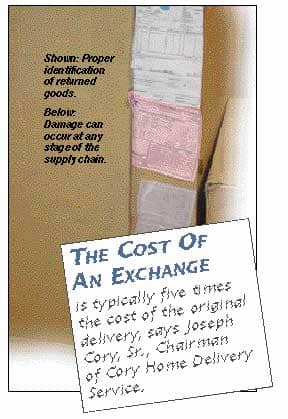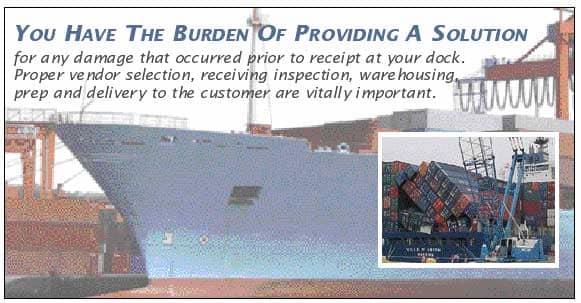5% Of Case Pieces And 3% Of Upholstery Are Delivered Damaged
In April I participated in the International Furniture Transportation and Logistics Council annual conference. This exceptional 45 year old organization's managing director Ray Bohman is recognized for his knowledge and leadership of furniture packaging and transportation. This gathering included more than 120 industry executives representing USA/ Canadian retailers as well as transportation companies operating domestically and worldwide.
In the span of 45 years, the transportation and delivery system has changed from a highly regulated industry to one where minimal regulation is the rule. At the same time, home furnishings retailers have moved from domestic to international sourcing. This council has kept pace with the ever changing transportation scene and is dedicated to getting products from manufacturers to retailers and their consumers in good condition.

The longer and more complex supply chain puts additional pressure on retailers to achieve perfect deliveries to the customer's home. Whether you run your own distribution center and deliver with your own drivers or use an outside company for all or a portion of these functions, you will take the heat or the credit for the arrival condition of furniture you place in your customers’ homes.
The latest available NHFA report notes that 5% of the case goods and 3% of upholstery and accessory items are received damaged. Retailers that buy in full truckload lots have less damage than retailers that rely on LTL transportation because it is handled fewer times. Specialized furniture companies do a better job than general carriers that haul furniture mixed with other commodities. Specializing in handling furniture, these carriers provide training for their drivers on furniture and accessory handling techniques. I would add that this is especially true for manufacturers that deliver in their own trucks or use dedicated transportation.
The packaging used by some manufacturers also contributes to high damage rates. Retailers should avoid purchasing from suppliers who use low quality corrugated and insufficient interior packaging that doesn't comply with shipping standards. Fortunately, there are suppliers that specify and enforce packaging standards on the plants they either own offshore or contract with. The carriers delivering to your dock truly want to do the best possible job but they have to deal with what they are presented with.
Since your store name is the name the customer will remember if she is not pleased, you have the burden of providing a solution for any deficiency that occurred prior to the delivery of items to your dock. You must do proper vendor selection, receiving inspection, warehousing, prep and delivery to the customer. Previous articles have appeared in Furniture World on those techniques but I will summarize a portion of one of this year's International Furniture Transportation and Logistics Council sessions that dealt with satisfying customers at the time of home delivery.

The session dealt with problems that become evident at the customer's home and the high cost of taking corrective action at that point. Joseph Cory, Sr., Chairman of Cory Home Delivery Service got everyone's attention when he stated that the cost of doing an exchange is typically five times the cost of the original delivery. When you consider the various steps, Joe's statement makes absolute sense. You may schedule a service technician first to verify and hopefully fix the situation. When that doesn't work, it's likely you will have to order a replacement and deliver it to the customer and pick up the original piece. On return to the warehouse, it has to be checked in, inspected and a disposition decision made. It may be sent to clearance (with or without having been repaired), donated, scrapped or sold as salvage. If it is a vendor quality issue they may offer an additional discount which still involves work for you. If they want it shipped back, you have to package it for safe transit and handle the necessary paperwork for shipping and credit processing. All too often, these costs exceed the margin or even the total cost of the item. There are, in addition, costs associated with unnesessary customer agitation, future lost business, and negative word of mouth advertising.
Some of the Benchmark Retailers I work with achieve 97% or greater perfect deliveries. They do this by following all the fundamentals of doing it right the first time, before the merchandise is put on the truck for delivery. Surprising as it may sound, some of the readers of this article won't know what their Perfect Delivery Score is. So my parting comment is this. “If you don't measure performance, you cannot improve performance.
For more information on the International Furniture Transportation and Logistics Council, Inc visit www.iftlc.org or phone 978-632-1913.
Contributing editor Dan Bolger of The Bolger Group helps companies achieve improved transportation, warehousing and logistics. You can send inquiries on any aspect of transportation, warehousing or logistics issues to Dan at dbolger@furninfo.com.